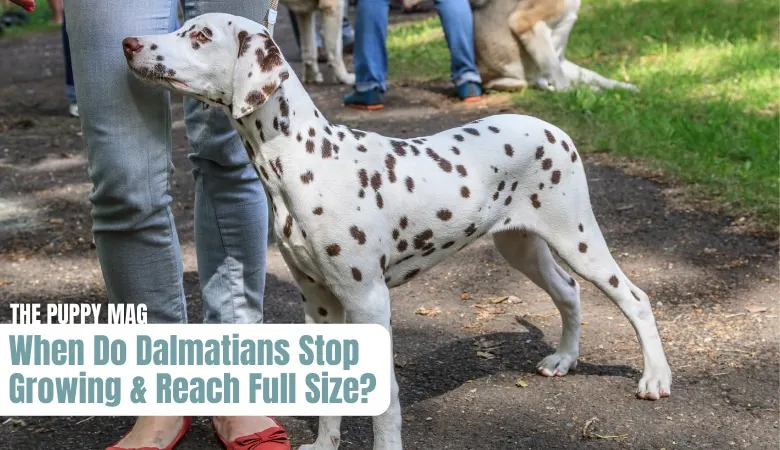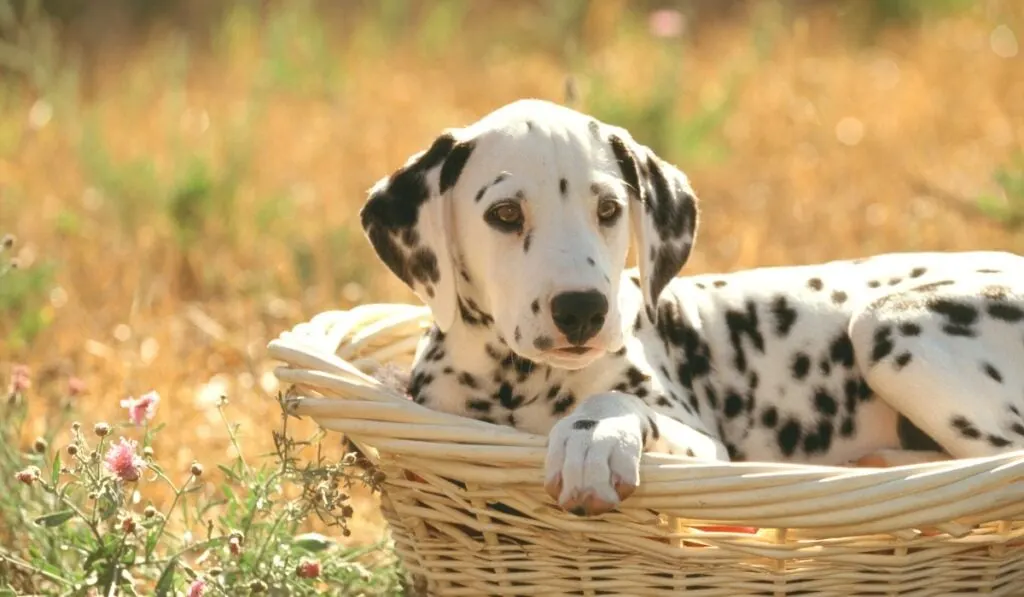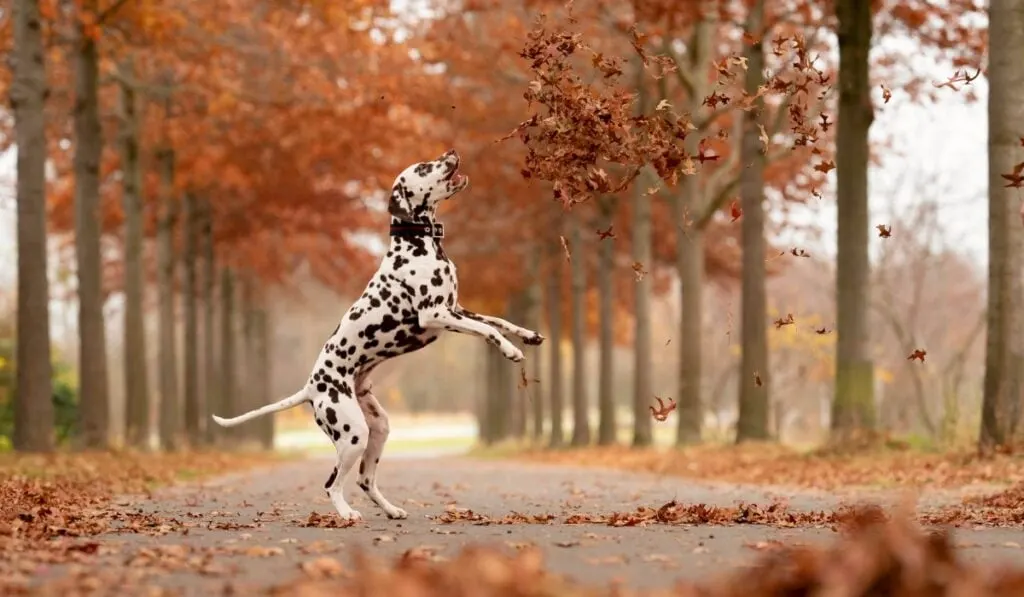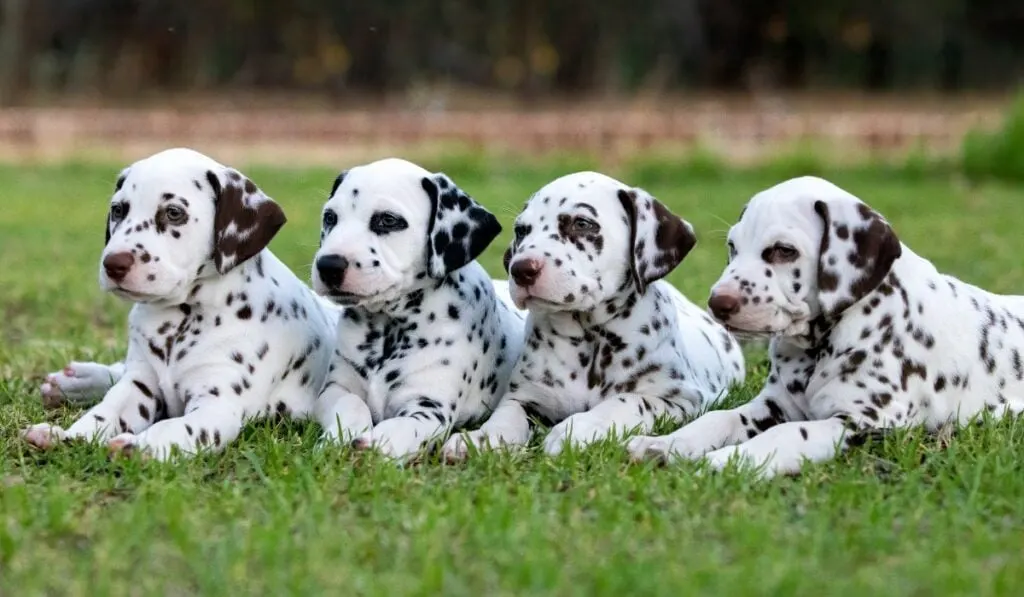Knowing when your Dalmatian will finally stop growing and reach their full size isn’t so straightforward.
Just when you think they can’t get any bigger, they keep on growing!
This article has everything you need to know including a detailed growth chart.

Table of Contents
When Do Dalmatians Stop Growing?
Most Dalmatians are fully grown by 16 months, apart from a few exceptions. Males typically take longer to stop growing than females due to greater muscle mass development.
It’s worth noting the difference between a Dalmatian’s full height and full weight because both are reached at different stages.
Height:
Both male and female Dals will reach their full height between 10-12 months. It’s extremely rare to see a Dalmatian continue to gain height after 12 months.
Weight:
Full weight can take up to around 16 months. Some females might reach their weight a little sooner, and some males may take a little longer, but on average 16 months is the final growth mark.

How Big Do Dalmatians Get?
It’s no secret that Dalmatians can grow to be pretty big, but just how big can they grow to be?
A fully grown Dalmatian will range from 19-24 Inches in height and 45-70 Pounds in weight, depending on gender. As expected, female Dalmatians are usually shorter and lighter than male Dalmatians.
As well as considering the breed standard information from the AKC, I scoured online forums, dalmatian groups and made online polls to get the most accurate data. Here are the averages.
Male Dalmatian Size Average:
Height: 21-24 Inches
Weight: 50-70 Pounds (22-31kg)
Female Dalmatian Size Average:
Height: 19-22 Inches
Weight: 45-60 Pounds (20-27kg)
While most Dals will fit somewhere within these ranges, it’s important to keep in mind these are averages.
I’ve seen a few reports of Dalmatians being bigger in both height and weight, albeit very rare. In cases like this, it’s likely that selective breeding has taken place in order to produce exceptionally large offspring.
And of course, cross-breeding can produce many different outcomes.
Trending article: When do Dalmatians go into heat? (What to know)

Dalmatian Puppy Growth Chart
Check out the chart below for a detailed overview month by month. Again, these numbers are just averages, so although most Dals will follow them closely, don’t be alarmed if your Dal is off by a few pounds here and there.
Weight is in Pounds and represents the (low-high) average.
| Dalmatian Age | Male Weight | Female Weight |
|---|---|---|
| 3 Months | 14-24 | 13-22 |
| 4 Months | 19-31 | 17-29 |
| 5 Months | 23-38 | 21-35 |
| 6 Months | 27-45 | 24-39 |
| 7 Months | 31-50 | 27-41 |
| 8 Months | 35-55 | 30-45 |
| 9 Months | 38-60 | 32-48 |
| 10 Months | 42-64 | 34-50 |
| 12 Months | 47-68 | 37-53 |
| 16 Months | 50-70 | 39-55 + |
Let’s round up some of the key information in the chart above:
- At 3 months old, a male Dalmatian will weigh between 14-24 pounds (6-10kg)
- At 6 months old, a male Dalmatian will weigh between 27-45 pounds (12-20kg)
- At 3 months old, a female Dalmatian will weigh between 13-22 pounds (5-9.9kg)
- At 6 months old, a female Dalmatian will weigh between 24-39 pounds (10-17kg)

4 Factors That Affect Growth & Size
There are a few key factors that impact how big your Dal will get (and the speed at which they grow).
1. Genetics & Breeding
The most influential factor is of course your Dal’s genetics. Some dals are destined to be bigger or smaller than others, and we can usually look to the parents as a reliable indicator.
Due to genetics being so influential, selective breeding can have a big impact on size. Some breeders choose to only breed together the largest of dals with each other (or vice versa). What you end up with is a refined gene pool of dals destined to be exceptionally large (or small).
2. Diet & Nutrition
Your Dal’s diet and nutrition will also impact growth to a certain extent. A quality diet that your Dal get’s on with will result in better absorption of the necessary nutrients it takes to grow.
A low quality diet or one that your Dalmatian doesn’t digest well, may result in a lack of nutrients, and potentially hinder growth. It’s crucial to find a high quality diet that your Dal loves. This will give him the best shot at growing to his full potential.
Dals are an energetic working breed that thrives on a high protein, medium to high fat, and low carbohydrate diet. Avoid high-carb diets and stick to those that prioritize protein. This will aid growth and recovery during the rapid growth spurt phase. And of course, avoid preservatives, additives, artificial nonsense and chemicals.
3. Rest & Recovery
Most of your Dal’s growing will happen when they are resting, not sprinting at full speed. Growing takes a lot of energy, and this is precisely why puppies can sleep anywhere between 16-22 hours a day!
One way to ensure your Dal grows to their full potential is to allow your puppy to nap and sleep as much as they want. Provide them with a comfortable bed and an environment that they feel safe in.
If you have young children, try your best to explain (for the 100th time no doubt) that we must always let our puppies rest whenever they are napping or sleeping.
4. Correct Exercise
This goes hand in hand with rest and recovery. Although exercising your puppy is important (as it stimulates muscle growth) it’s crucial NOT to overexercise them.
Exercising a puppy can put unnecessary strain on their fragile bones and joints, and in the worst of cases cause short or long-term injury. If this happens, it can certainly affect their growth to some extent.
Here’s an article explaining everything about Dalmatian exercise.
When Do Dalmatians Mature Mentally?
We’ve covered physical maturity, but what about mental maturity?
Dalmatians usually aren’t considered mentally mature until around 2-3 years of age. And even then, nothings a guarantee.
Many owners wonder when their dalmatian will calm down, but the truth is that age is not the answer. While a Dal might become “mentally mature” it doesn’t necessarily mean they find their “zen” and meditate all day…
Most Dals will continue to have incredible energy levels way beyond the age of 3.
Are Male Dalmatians Always Bigger Than Females?
In most cases, yes, male Dalmatians are commonly bigger than females. Males are slightly taller and weigh more due to having more muscle mass.
However, this doesn’t necessarily mean that all females are smaller than all males though…
In some cases where a female Dal grows to be exceptionally large, they will certainly be bigger than some of the smaller male Dals out there.
This can happen easily since the difference between male and female size isn’t that big, to begin with. Large females will usually be bigger than small males.
Summary: Key Points
Let’s run through a summary of the key information within the article.
- Dalmatians stop growing around 16 months old. In some cases, large males might take a little longer to stop growing, but on average, most Dals will stop by 16 months old.
- Dalmatians grow to be between 19-24 Inches in height and 45-70 Pounds in weight, depending on gender. Males are usually taller and heavier than females.
- Dalmatians at 6 months old weigh between 24-45 Pounds. Males are towards the higher end of this range and females the lower end.
- Dalmatians at 1 year old weigh between 37-68 Pounds. Males are towards the higher end of this range and females the lower end.
- Dalmatians do not mentally mature until around 2-3 years old, sometimes even longer.
- In some cases, large female Dalmatians will grow to be bigger than the small male Dals.
Thank you for reading! Be sure to check out more Dalmatian articles >>>
